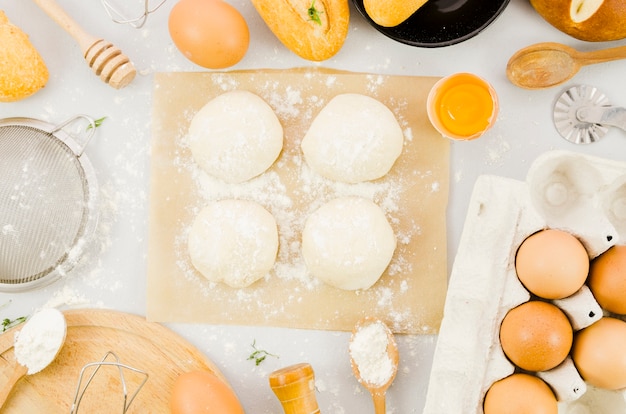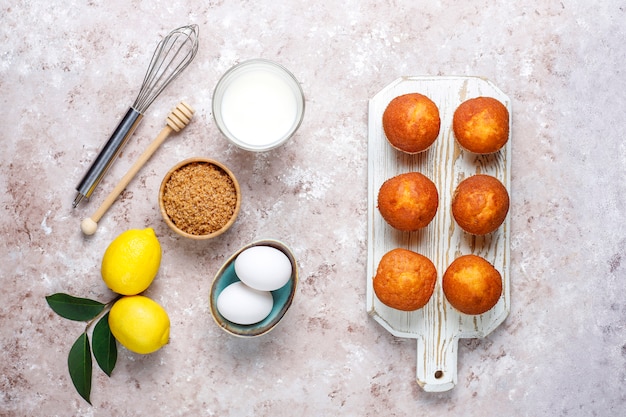Let’s face it, we all love a good egg muffin. They're the perfect on-the-go breakfast or a satisfying snack. But let’s be honest, mastering the art of the perfect egg muffin can feel like a bit of a culinary mystery. Too long in the oven and you’ve got a dry, rubbery mess. Not long enough, and you’re left with a runny, jiggly disaster. Sound familiar?
Fear not, my fellow egg muffin enthusiasts! I've been there, and I'm here to guide you through the process, sharing my hard-earned wisdom and tips to ensure you achieve perfectly cooked, delicious egg muffins every time. This comprehensive guide will cover everything from the basic ingredients to the different cooking methods, the secrets to achieving that perfect texture, and some of my favourite flavour combinations. Grab a cuppa, settle in, and let's get started!
Part 1: The Basics

Before we embark on this culinary journey, we need to lay the groundwork, just like prepping the stage for a fantastic performance. Let's get acquainted with the essential ingredients and equipment needed to create those delightful egg muffins.
Essential Ingredients
The beauty of egg muffins lies in their versatility. You can essentially add whatever strikes your fancy, but there are certain key ingredients that form the foundation of a fantastic egg muffin:
- Eggs: The star of the show, of course! Opt for free-range eggs if you can, as they tend to be tastier and richer.
- Milk: This is the secret ingredient for achieving that luscious, moist texture. Semi-skimmed or full-fat milk works just fine, depending on your preference.
- Salt and Pepper: A dash of salt and pepper is essential for enhancing the natural flavours of the eggs.
- Cheese: Oh, the cheese! This is a must-have for any self-respecting egg muffin. Cheddar, mozzarella, Parmesan, or even a mix of different cheeses can add a delightful richness and creaminess.
- Vegetables: The possibilities are endless here! Spinach, peppers, mushrooms, onions, diced tomatoes, even zucchini – let your creativity guide you. Remember, a little goes a long way, especially when it comes to vegetables.
- Meat: For a more substantial and flavourful muffin, consider adding some bacon, sausage, ham, or even leftover cooked chicken. Just ensure it’s chopped or crumbled for easy distribution.
Equipment You’ll Need
Now, let's talk about the tools of the trade. You don't need a fancy kitchen to make egg muffins. In fact, you probably already have everything you need in your cupboards:
- Muffin Tin: This is the essential vessel for shaping those perfect little egg muffins. A standard 12-cup muffin tin is ideal, but smaller ones are perfect if you’re only making a few.
- Whisk: This handy tool will be your best friend for whipping the eggs, milk, and spices together, creating a smooth and airy batter.
- Measuring Cups and Spoons: These are your trusty guides for precise measurements, especially if you're following a recipe.
- Spatula: You'll need a spatula to carefully transfer the egg mixture into the muffin tins.
- Oven: If you're embracing the oven-baked method, which I highly recommend for that even cooking and delicious texture, you'll need a trusty oven.
Part 2: The Cooking Methods

Here we delve into the heart of the matter – the various methods for cooking your egg muffins. The cooking method you choose will significantly impact the final outcome, so let's explore the most popular options and their advantages and drawbacks.
Oven-Baked Egg Muffins
This is my personal favourite method! It consistently delivers the most even cooking and results in a wonderfully fluffy texture that simply melts in your mouth. Plus, you can bake an entire batch at once, making it perfect for meal prepping or feeding a crowd.
Pros
- Even Cooking: No more unevenly cooked, undercooked, or overcooked muffins! The oven ensures they're cooked through and perfectly golden brown.
- Versatile: You can bake these beauties in a standard muffin tin, a silicone muffin pan, or even individual ramekins, giving you flexibility in your baking.
- Easy to Clean: Simply pop the muffin tin in the dishwasher and you’re good to go. No complicated scrubbing required.
Cons
- Takes a Bit Longer: Baking typically takes around 20-25 minutes, which is slightly longer than some other methods.
- Uses More Energy: Since you’re using the oven, it’s not the most energy-efficient option.
microwave egg muffins
This is the go-to method for those short on time. You can have a couple of egg muffins ready in a matter of minutes, perfect for a quick breakfast or a snack. Just be mindful not to overcook them!
Pros
- Super Fast: You can have delicious egg muffins on your plate in a matter of minutes.
- Easy: Simply pour your prepared egg mixture into a microwave-safe bowl, cover it (to prevent splattering), and zap it!
- Great for Small Batches: Ideal if you’re only cooking for yourself or one other person.
Cons
- Not as Even Cooking: You might end up with some parts overcooked and others undercooked.
- Can Be Messy: The egg mixture can splatter in the microwave, so it’s best to cover it with a lid or cling film.
- Limited in Size: You can only cook a few muffins at a time.
Stovetop Egg Muffins
This method involves using a nonstick pan to cook your egg muffins. It's a bit more hands-on, but with a little practice, you can achieve impressive results.
Pros
- Quick and Easy: You can cook a few muffins in about 5-7 minutes.
- No Oven Required: Perfect for those who want to avoid heating up the entire house.
Cons
- Can Be Tricky: It takes a bit of practice to get the cooking time just right.
- Limited in Size: You can only cook a few muffins at a time.
Part 3: Perfecting Your Technique

Now we’re getting into the nitty-gritty – the tricks and techniques that will transform your egg muffins from ordinary to extraordinary.
The Importance of Whipping
Don’t just haphazardly toss everything into a bowl and call it a day. A little effort goes a long way when it comes to egg muffins. Whipping the eggs and milk together until they're light and frothy is crucial for achieving that fluffy, airy texture. It’s the difference between a muffin that melts in your mouth and one that feels like you're chewing on a rubbery egg.
Choosing the Right Pan
Your choice of pan can make a world of difference. Silicone muffin tins are a godsend because they don't stick, making it a breeze to remove the muffins. But if you're using a metal tin, be sure to grease it thoroughly with butter or cooking spray to prevent sticking.
Avoiding Overcooking
This is the most common mistake people make when cooking egg muffins. It’s a delicate balance: you want them cooked through but not dry. Here's how to avoid the dreaded overcooked muffin:
- Keep a Vigilant Eye: Don’t just shove them in the oven and forget about them! Check on them regularly.
- Use a Timer: A timer is your best friend in the kitchen. Set it for a few minutes less than the recommended time in your recipe, then check on them.
- Don't Overfill the Tins: Leave a little space at the top for the muffins to rise.
Part 4: Texture Tips
So, you've got your oven-baked, fluffy egg muffins. But how do you ensure they're perfectly moist and not dry as a biscuit?
The Secret to Moisture
The key to moist egg muffins is adding enough liquid. Don't be afraid to use a bit more milk than you think you need. You can also add a splash of cream or even a little bit of yoghurt to amp up the lusciousness.
Adding Vegetables
Vegetables are your secret weapon for adding moisture and flavor to your egg muffins. But be mindful not to overdo it. You want a nice balance of egg and vegetables, not a soggy mess.
Cheese, Cheese, Cheese
Don't forget the cheese! It's the perfect ingredient for adding richness and flavour. I love a mix of cheddar and mozzarella, but feel free to experiment with different types to discover your favorites.
Part 5: Flavour Combinations
Now we're getting into the exciting part – unleashing your creativity with endless flavour combinations. The possibilities are truly endless, so let your imagination run wild. Here are a few of my personal favorites:
Classic Cheesy
This is the ultimate comfort food! Simply add a generous amount of cheddar cheese to your egg mixture and bake until golden brown. A pinch of black pepper elevates the flavor.
Spinach and Feta
This is a healthy and delicious option. Just wilt some spinach in a pan and mix it into your egg mixture with some crumbled feta cheese. Season with salt and pepper. A pinch of nutmeg adds an extra touch of flavour.
Bacon and Cheddar
This classic combination never disappoints. Fry some bacon until crispy, then crumble it into your egg mixture with some cheddar cheese. It's a truly indulgent breakfast treat.
Chorizo and Manchego
For a touch of Spanish flair, try chorizo and manchego cheese. Fry the chorizo until crispy and then add it to your egg mixture with some grated manchego. Season with paprika and a pinch of smoked paprika for an extra kick.
Mushroom and Gruyère
This is a sophisticated flavor combination perfect for a fancy brunch. Sauté some mushrooms in a pan with garlic and thyme, then mix them into your egg mixture with some grated Gruyère cheese.
Part 6: Storing and Reheating
Now that you've got those perfect egg muffins, let's talk about how to store and reheat them for maximum enjoyment.
Storing Leftovers
Let the muffins cool completely before storing them in an airtight container in the refrigerator. They should keep well for up to 3-4 days.
Reheating
There are a few ways to reheat your egg muffins, each yielding a slightly different result. Choose the method that best suits your preference and situation:
- Oven: This is the best method for achieving that crispy texture we all love. Preheat your oven to 180°C (350°F) and heat the muffins for 5-10 minutes, or until heated through.
- Microwave: This is a quick and easy option, but it might not give you that same crispy texture. Heat for 30-60 seconds, or until heated through.
- Toaster Oven: A good option if you want a bit of browning on the outside. Heat the muffins for a few minutes, or until heated through.
Part 7: Troubleshooting Tips
We've covered the basics, the cooking methods, and the flavour combos. But what happens when things don't go exactly as planned? Don't worry! I'm here to help you troubleshoot those common egg muffin mishaps.
My Egg Muffins Are Too Dry
This is a common problem, especially for those new to egg muffin cooking. Here's how to fix it:
- Add More Milk: The easiest solution is to add a tablespoon or two of milk to your egg mixture before baking.
- Use a Lower Oven Temperature: A lower temperature will help prevent the muffins from drying out.
- Bake for a Shorter Time: Keep an eye on them and check them regularly with a toothpick.
My Egg Muffins Are Too Wet
If your muffins are too wet, they’ll be a bit mushy and might not hold their shape well. Here's how to avoid this:
- Reduce the Amount of Milk: Start with a bit less milk and add more gradually if needed.
- Use a Higher Oven Temperature: This will help to cook the muffins more quickly and prevent them from becoming soggy.
- Bake for a Longer Time: Keep an eye on the muffins and bake them for a few minutes longer if necessary.
My Egg Muffins Are Sticking to the Tin
This is a real pain! But it's easily avoided with a little bit of preparation:
- Grease the Tin: Use a good amount of butter or cooking spray to coat the muffin tin.
- Use Silicone Muffin Cups: These are non-stick and make it super easy to remove the muffins.
- Let Them Cool Completely: Before attempting to remove the muffins, let them cool completely in the tin.
Part 8: The Final Verdict
There you have it! My ultimate guide to egg muffin cooking time. I've shared my tips, tricks, and favorite recipes to help you create the perfect egg muffin every time. Remember, it’s all about practice and experimentation. Don’t be afraid to get creative with your ingredients and flavors!
So, what are you waiting for? Grab those eggs and get cooking! I’m off to whip up a batch of my Bacon and Cheddar egg muffins – they’re calling my name! Let me know in the comments below if you have any questions or want to share your favorite egg muffin recipes. Happy cooking!
FAQs
I know you might have some questions about cooking egg muffins, so here are some answers to the most common ones:
| Question | Answer |
|---|---|
| Can I freeze egg muffins? | Absolutely! Let them cool completely, then store them in an airtight container in the freezer for up to 3 months. To reheat, thaw them in the refrigerator overnight and then reheat them in the oven or microwave. |
| How do I know when my egg muffins are cooked through? | You can check them with a toothpick or skewer. If it comes out clean, they’re done. If there’s still wet batter on the toothpick, they need to bake a little longer. |
| What can I use instead of milk? | You can use water, cream, yoghurt, or even almond milk. Just adjust the amount to get the desired consistency. |
| Can I make egg muffins with other types of eggs? | Yes, you can use quail eggs, duck eggs, or even goose eggs. Just adjust the cooking time accordingly. |
| What are some other healthy additions to egg muffins? | You can add chopped avocado, diced tomatoes, or even some shredded sweet potato to your egg muffins. |
Everyone is watching

Corn on the Cob: The Ultimate Guide to Perfectly Cooked Ears
Healthy MealsAh, corn on the cob. Just the name evokes images of sunny days, barbecues, and that sweet, juicy flavour that ...

Perfect Pork Roast Oven Cooking Time: A Guide to Delicious Results
Healthy MealsThere's something truly satisfying about a perfectly roasted pork. The aroma alone is enough to make your mout...

Ham Cooking Time: How Long to Bake, Smoke, or Boil a Delicious Ham
Healthy MealsAh, ham. It's a classic, isn't it? A real crowd-pleaser, especially around holidays. And when done right, it'...

Scallops: The Ultimate Guide to Perfect Cooking
Healthy MealsAh, scallops. Those delicate, sweet, and utterly delicious morsels of the sea. They hold a special place in my...

Spaghetti Squash: The Ultimate Guide to Cooking and Serving
Healthy MealsRemember that time you saw spaghetti squash at the supermarket, looking all bumpy and strange, and thought, "W...
